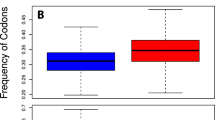Abstract
We previously showed that GAU codons are preferred (relative to synonymous GAC codons) for encoding aspartates specifically at the N-termini of α-helices in human, but not in E. coli, proteins. To test if this difference reflected a general difference between eucaryotes and procaryotes, we now extended the analysis to include the proteins and coding sequences of mammals, vertebrates, S. cerevisiae, and plants. We found that the GAU-α-helix correlation is also strong in non-human mammalian and vertebrate proteins but is much weaker or insignificant in S. cerevisiae and plants. The vertebrate correlations are of sufficient strength to enhance α-helix N-terminus prediction. Additional results, including the observation that the correlation is significantly enhanced when proteins that are known to be correctly expressed in recombinant procaryotic systems are excluded, suggest that the correlation is induced at the level of protein translation and folding and not at the nucleic acid level. To the best of our knowledge, it is not explicable by the canonical picture of protein expression and folding, suggesting the existence of a novel evolutionary selection mechanism. One possible explanation is that some α-helix N-terminal GAU codons may facilitate correct co-translational folding in vertebrates.
Similar content being viewed by others
Author information
Authors and Affiliations
Rights and permissions
About this article
Cite this article
Orešič, M., Dehn, M., Korenblum, D. et al. Tracing Specific Synonymous Codon–Secondary Structure Correlations Through Evolution . J Mol Evol 56, 473–484 (2003). https://doi.org/10.1007/s00239-002-2418-x
Received:
Accepted:
Issue Date:
DOI: https://doi.org/10.1007/s00239-002-2418-x




